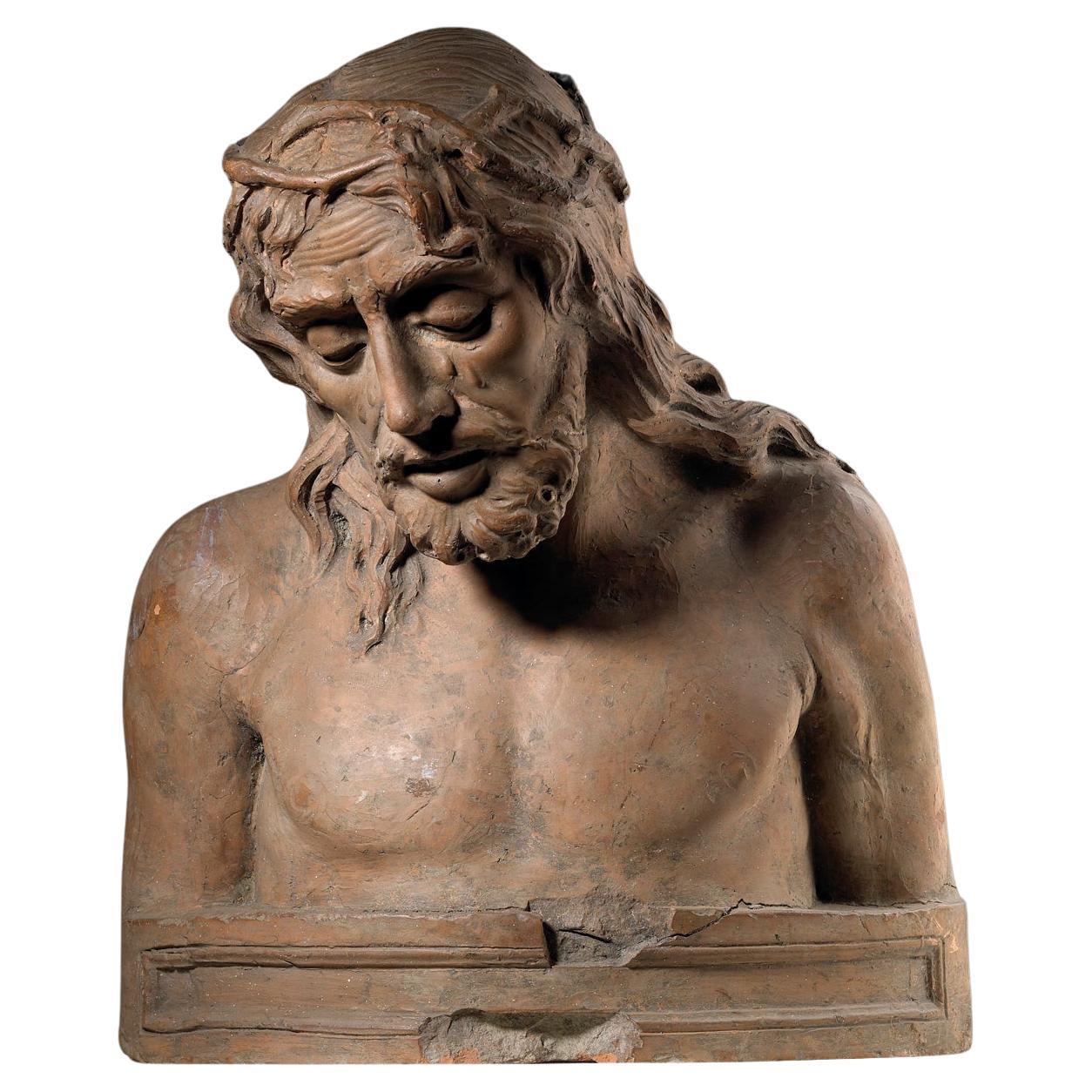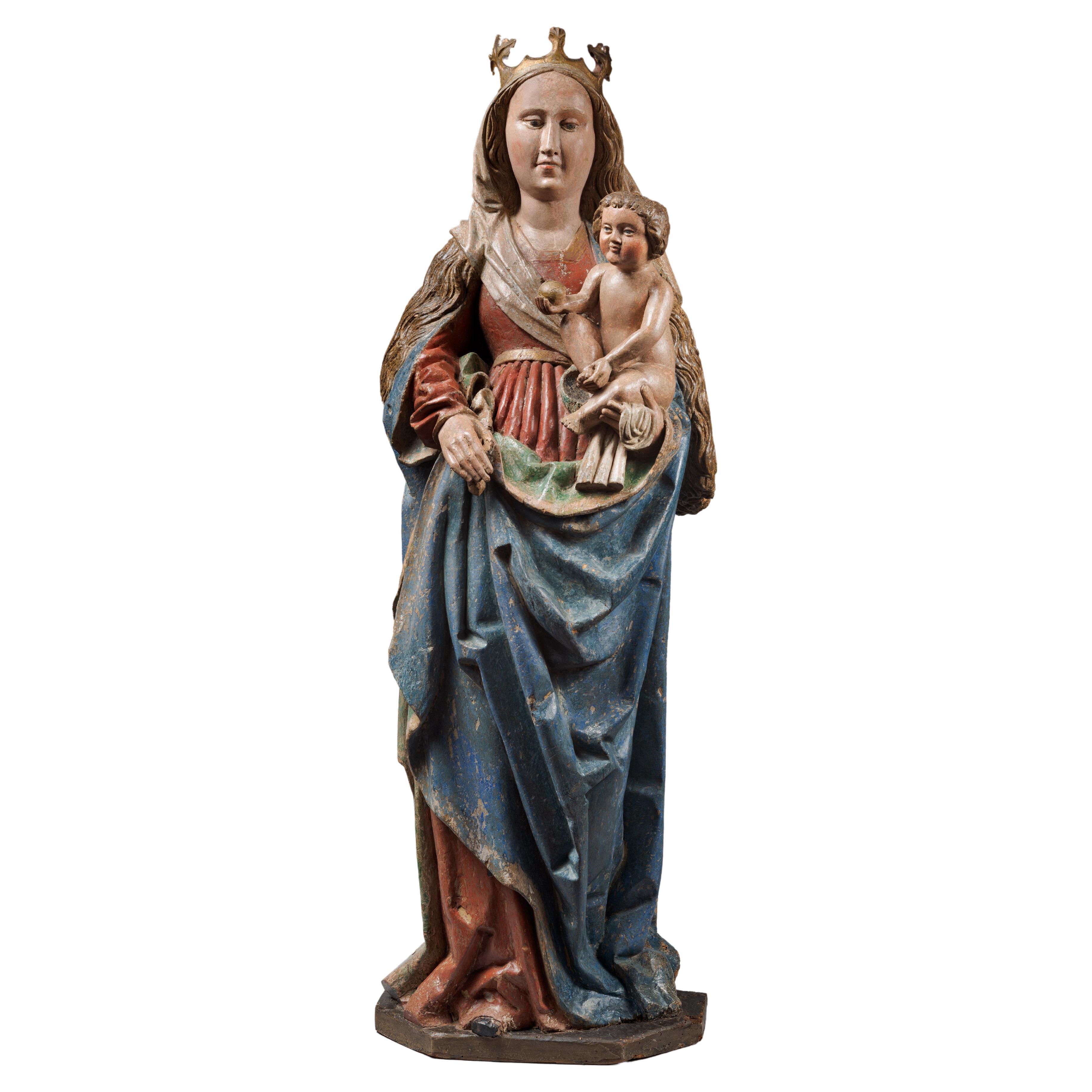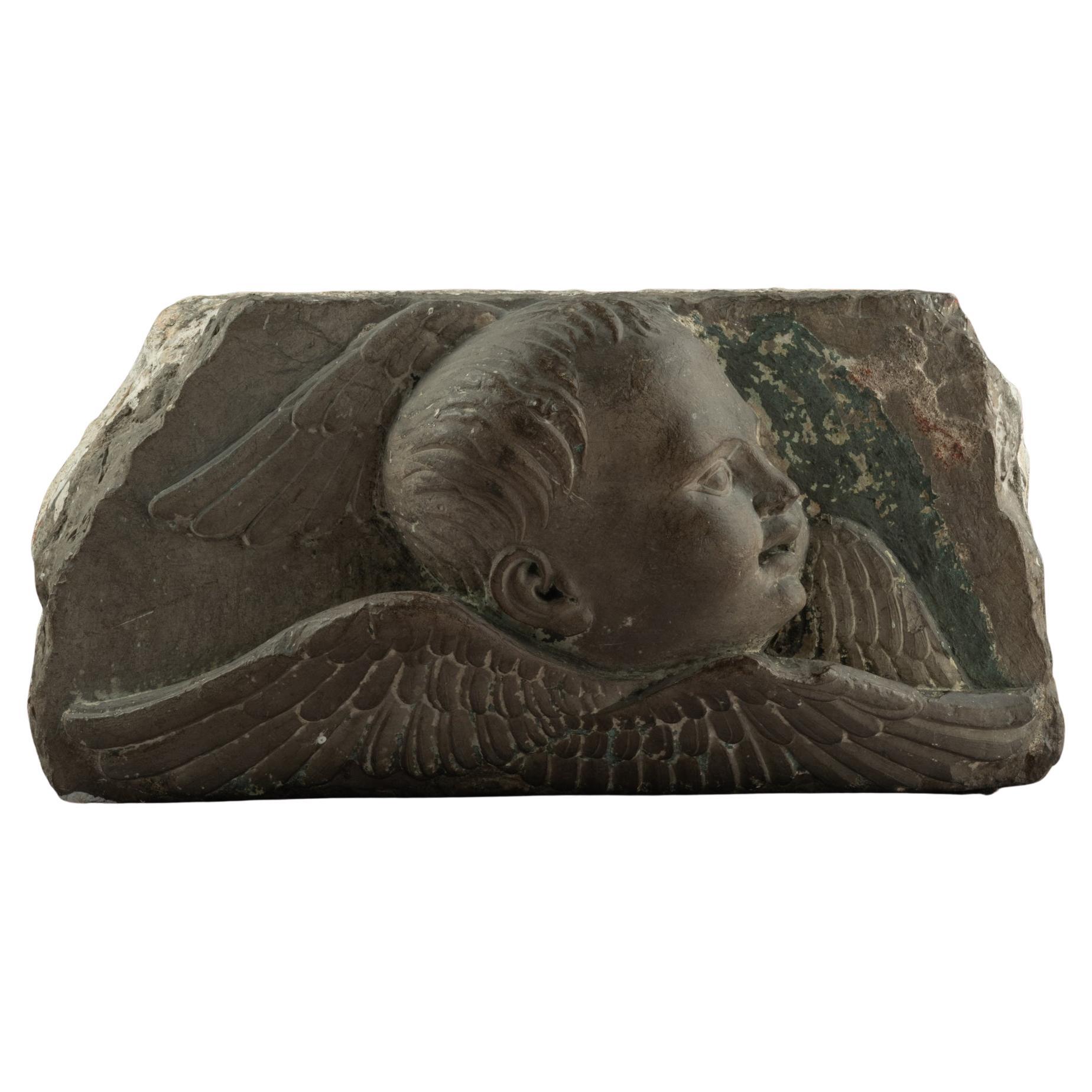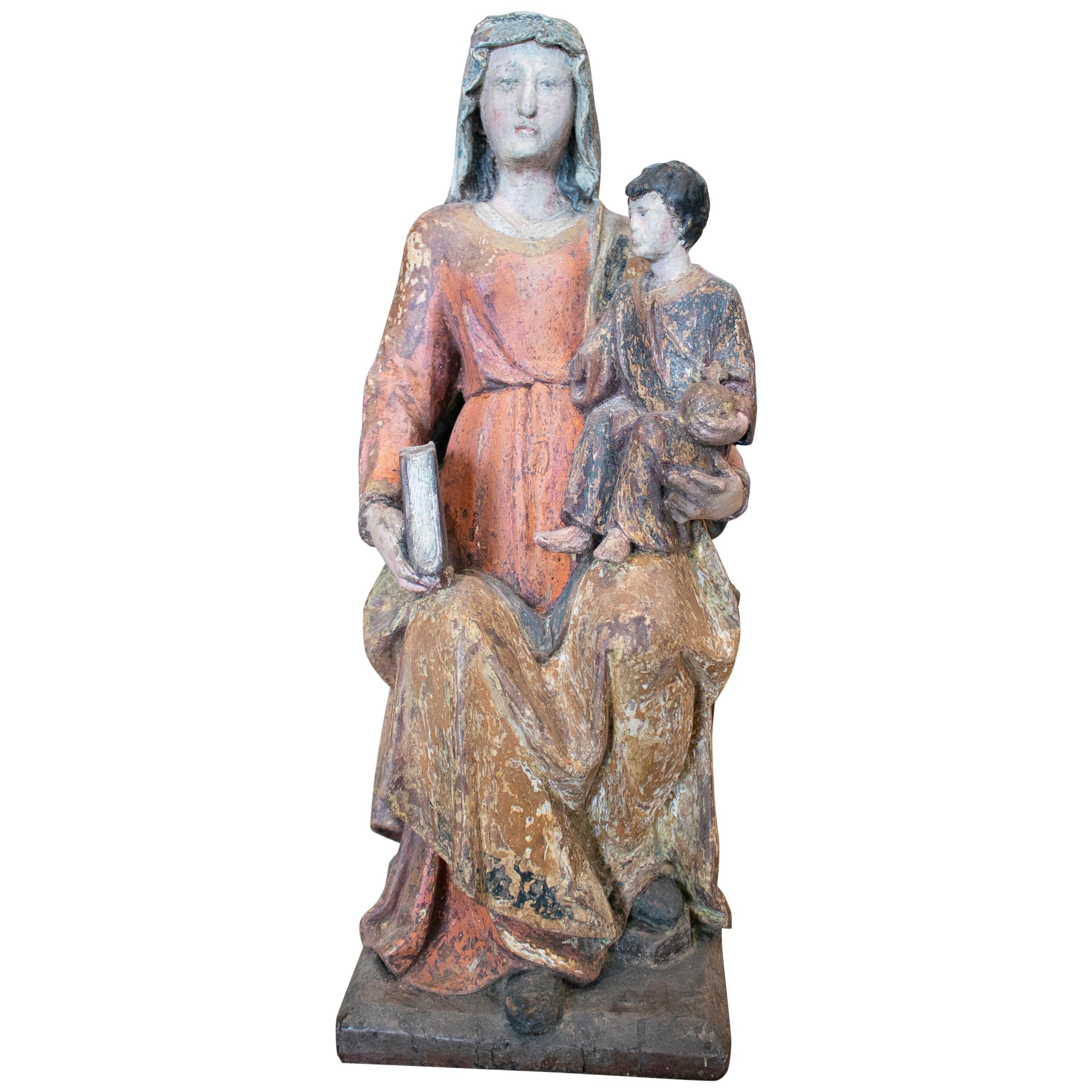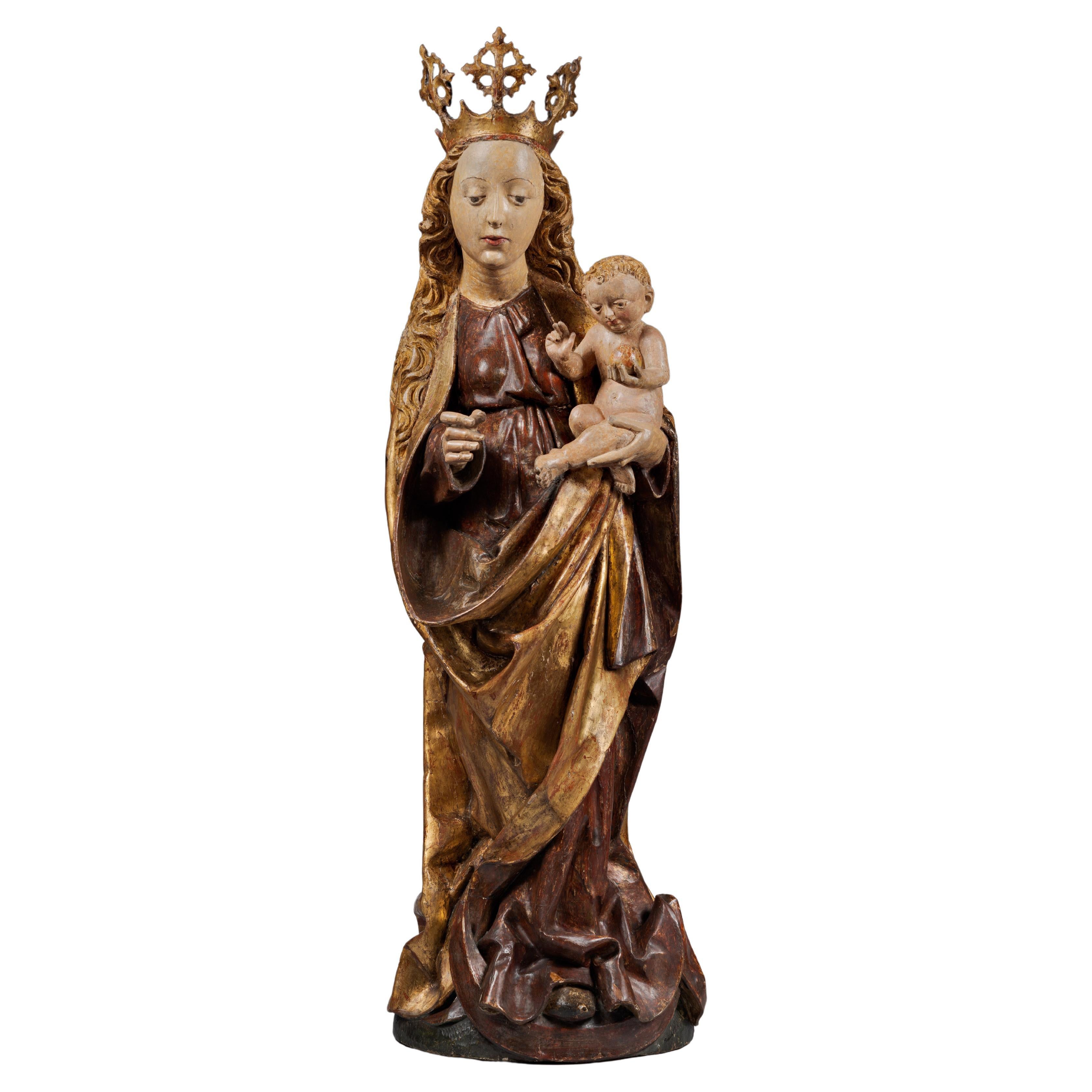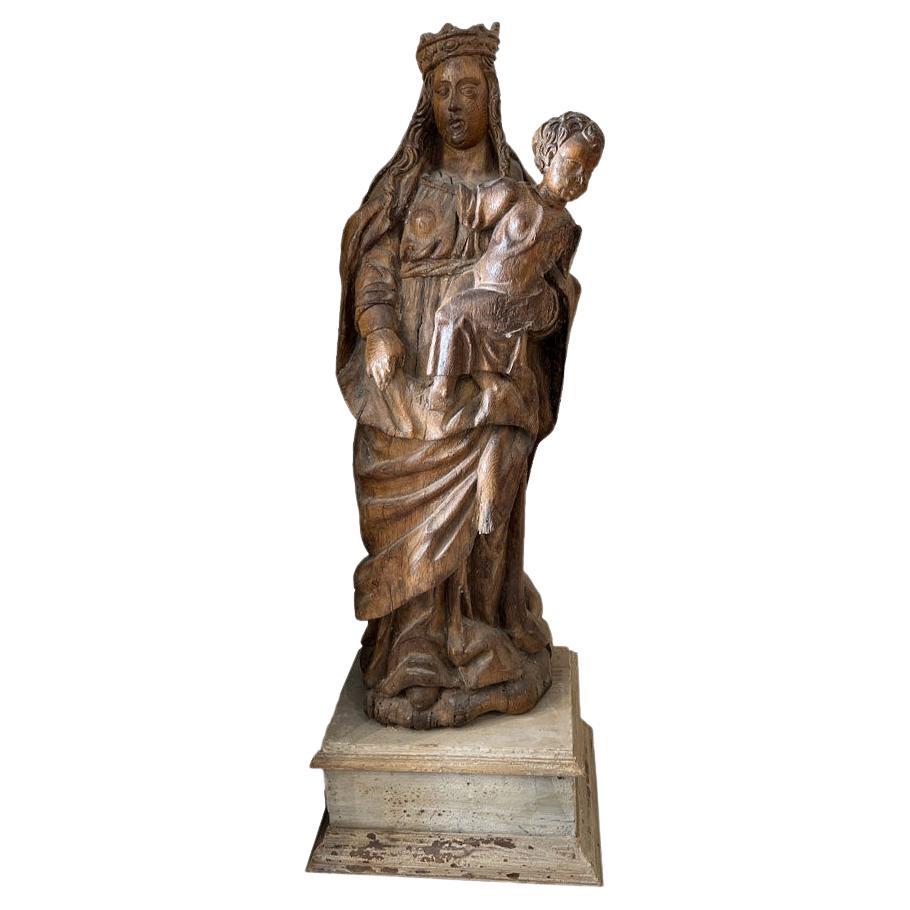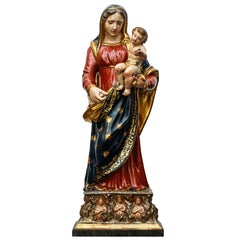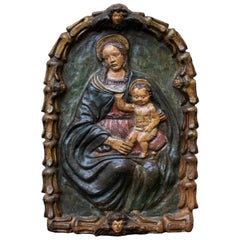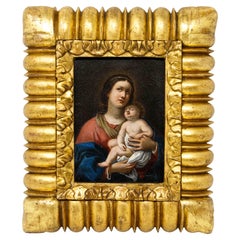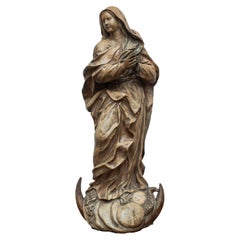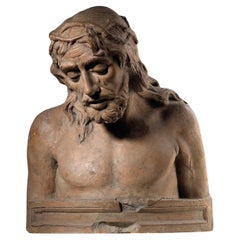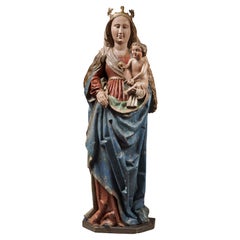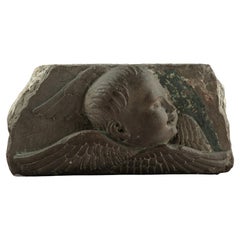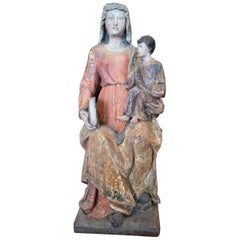Items Similar to 15th century, Florence, Madonna and Child
Want more images or videos?
Request additional images or videos from the seller
1 of 7
15th century, Florence, Madonna and Child
About the Item
15th century, Florence
Madonna and Child
Painted stucco, 29 x 14 cm
This stucco Madonna of the 15th-century Florentine school exudes a gentleness and sacredness that is entirely congruous with the religiously oriented sculptural production at the turn of the Gothic and Renaissance periods. The composition is presented within an arched niche, an architectural element that frames and enhances the sacred figure. The Virgin Mary is seated, with the baby Jesus tenderly clasped in her arms. Their physical proximity conveys a strong sense of intimacy and maternal affection. The figures are modeled with a delicacy that reveals the mastery of the sculptor. The faces are serene and collected, with an expression of gentleness and devotion. Mary wears a dark mantle that wraps around her head and shoulders, leaving a glimpse of a robe underneath, bright red. The Child Jesus is depicted at a tender age, with a small, plump body typical of Renaissance child depictions: his pose is stance and dynamic. Both characters are haloed, as a symbol of their holiness, based on a legacy of the Gothic visual tradition. Stucco, the material used, clearly limited in cost compared to marble, allowed plastic and detailed modeling, although it was often then painted to add color and vibrancy. Traces of color can still be seen, suggesting that the work was originally polychrome. The style reflects the aesthetics of the early Florentine Renaissance, characterized by a search for balance, harmony, and a more naturalistic depiction of human figures, while maintaining a strong sense of idealization and spirituality. One senses a focus on soft, flowing line, and an attempt to render the plasticity of bodies through delicate chiaroscuro. The decorated base adds an element of richness to the work, suggesting that it was intended for private devotion or perhaps for a small altar. The iconography of the Virgin cloaked in red and clothed in blue gently supporting the Child, standing with a dynamic pose, is taken from the tabernacle, also in stucco, by Andrea del Verrocchio (Florence, 1435 - Venice, 1488) , currently on display at the Bandini Museum in Florence (inv. L. 41/1986).
- Dimensions:Height: 11.42 in (29 cm)Width: 5.52 in (14 cm)Depth: 1.58 in (4 cm)
- Style:Other (Of the Period)
- Materials and Techniques:
- Place of Origin:
- Period:
- Date of Manufacture:15th century
- Condition:Wear consistent with age and use.
- Seller Location:Milan, IT
- Reference Number:1stDibs: LU5918245119762
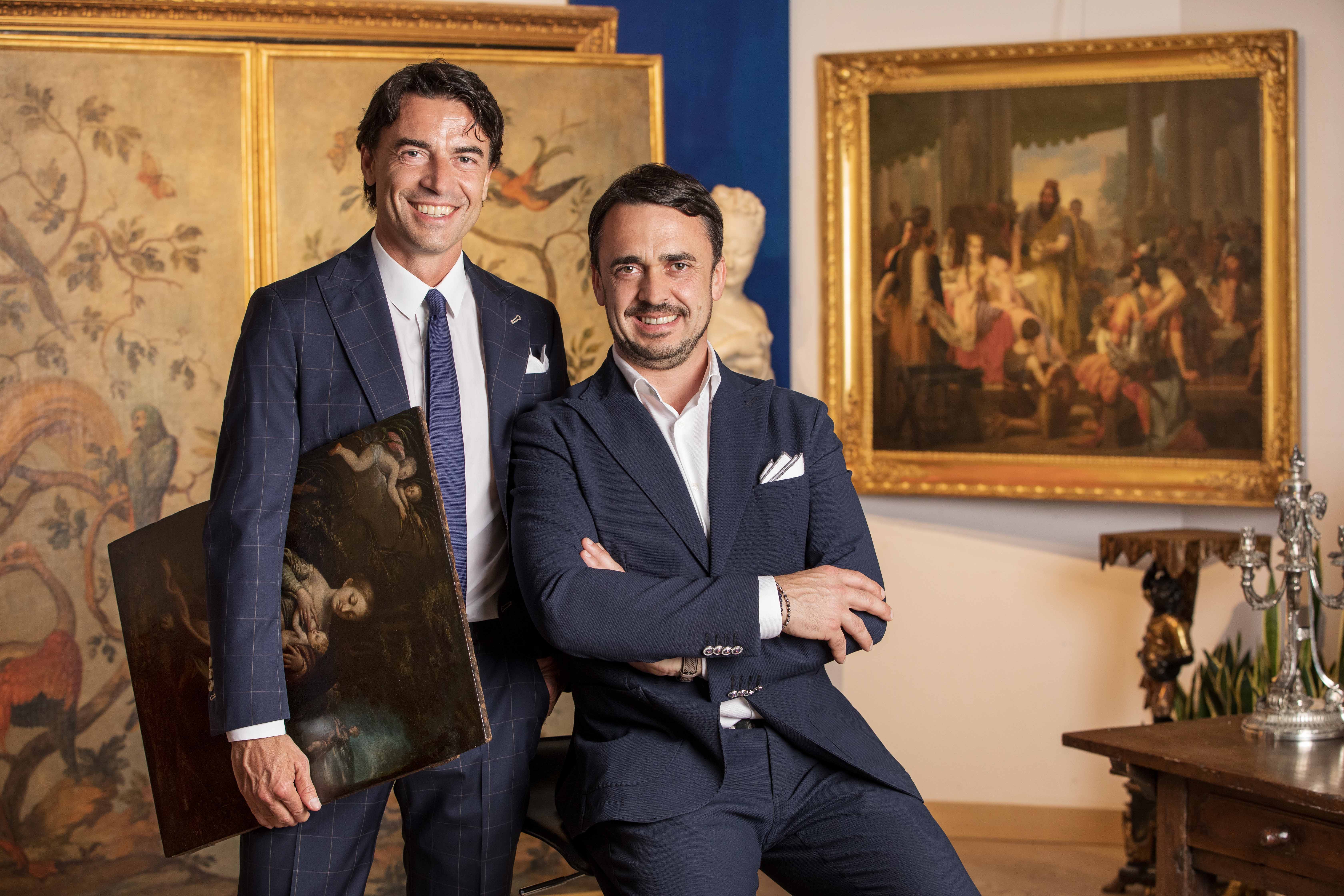
About the Seller
5.0
Vetted Professional Seller
Every seller passes strict standards for authenticity and reliability
Established in 2000
1stDibs seller since 2021
30 sales on 1stDibs
Typical response time: 21 hours
- ShippingRetrieving quote...Shipping from: Milan, Italy
- Return Policy
Authenticity Guarantee
In the unlikely event there’s an issue with an item’s authenticity, contact us within 1 year for a full refund. DetailsMoney-Back Guarantee
If your item is not as described, is damaged in transit, or does not arrive, contact us within 7 days for a full refund. Details24-Hour Cancellation
You have a 24-hour grace period in which to reconsider your purchase, with no questions asked.Vetted Professional Sellers
Our world-class sellers must adhere to strict standards for service and quality, maintaining the integrity of our listings.Price-Match Guarantee
If you find that a seller listed the same item for a lower price elsewhere, we’ll match it.Trusted Global Delivery
Our best-in-class carrier network provides specialized shipping options worldwide, including custom delivery.More From This Seller
View All19th Century Madonna and Child with Souls in Purgatory Papier-Mache Sculpture
Located in Milan, IT
First half of the 19th century
Madonna and Child with souls in Purgatory
Lacquered and gilded papier-mache with polychrome wooden base
cm 96.5 x 37.5 x 28
"At that time I asked the Lord Jesus: 'For whom do I still have to pray?'. Jesus answered me that the following night he would make me known for whom I had to pray. I saw the Custodian Angel, who ordered me to follow him. At a moment I found myself in a foggy place, invaded by fire and, in it, a huge crowd of suffering souls. These souls pray with great fervour, but without effectiveness for themselves: only we can help them. The flames that burned them, they did not touch me. My Guardian Angel did not abandon me for a moment. And I asked those souls what their greatest torment was. And they unanimously answered me that their greatest torment is the ardent desire of God. I read the Madonna who visited the souls of Purgatory. The souls call Mary 'Star of the Sea'. She brings them refreshment ".
(Diary of Sister Faustina Kowalska p. 11)
A Polish religious, Saint Faustina Kowalska (1905-1938) reinterpreted in the pages of her testimony the ancient role of the Virgin as savior and supporter of the souls of Purgatory. The Second Vatican Ecumenical Council established that, assumed into Heaven, the Mother of God should operate a continuous intercession in favor of those children waiting for Paradise who were in the place, quoted for the first time by Pope Gregory the Great...
Category
Antique Early 19th Century Italian Figurative Sculptures
Materials
Paper
17th Century Madonna with Child from the Impruneta Tondo Polychrome Terracotta
Located in Milan, IT
Tuscan school, 17th century
Madonna with Child - from the Impruneta Tondo
Measures: Polychrome terracotta, 65 x 46 x 10 cm
This polychrome terracotta relief, gently jutting...
Category
Antique 17th Century Italian Abstract Sculptures
Materials
Terracotta
Roman school, 17th century, Madonna and Child
Located in Milan, IT
Roman School, 17th century
Madonna and Child
Oil on copper, 15 x 11 cm
Framed, 26 x 22 cm
The small copper on display here depicts the Madonna and Child against a dark background...
Category
Antique 17th Century Italian Other Paintings
Materials
Copper
18th Century Immaculate Madonna Terracotta Sculpture
Located in Milan, IT
18th century
Immaculate Madonna
Terracotta, 53 x 22 x 20 cm
The work examined depicts the Virgin Mary treated according to the iconography of the Immaculate Virgin
The theme of the Immaculate Conception began to appear in artistic works ever since the debate began, which saw the Franciscans and the ramifications of the Benedictine Order lined up on one side, linked to the thought of Anselmo d'Aosta and Bonaventura da Bagnoregio, and on the other the Dominicans, linked to the discussion offered by Thomas Aquinas...
Category
Antique 18th Century European Figurative Sculptures
Materials
Terracotta
Mantuan school, 18th century, Madonna suckling the Child
Located in Milan, IT
Mantuan school, 18th century
Madonna suckling the Child
Oil on panel, 27.5x22 cm
The softly collected and intimate dimension suggested by the present painting underscores the cert...
Category
Antique 18th Century and Earlier Italian Other Paintings
Materials
Wood
16th century Madonna and Child Oil on canvas with gold background
Located in Milan, IT
XVII Century
Madonna and Child
Oil on canvas, 116 x 83 cm
The canvas under consideration depicts the Icon of the Most Holy Virgin Consoled, or more correctly Consoler of the Affl...
Category
Antique 17th Century Decorative Art
Materials
Canvas
You May Also Like
Ecce Homo - Florence, 15th century
Located in Bruxelles, BE
A terracotta bust "Ecce Homo"
Florence, 15th century
53 x 44 x 31 cm
Category
Antique 15th Century and Earlier Italian Renaissance Figurative Sculptures
Materials
Terracotta
Important 15th Century Polychrome Wood Virgin and Child
Located in Saint-Ouen, FR
Important 15th century polychrome wood virgin and child
Origin: Southern Germany
Period: Late 15th Century, Ca. 1480-1490
Height : 125 cm
Polychrome limewood
Good condition
Provenance : Private collection, Alsace, France.
As soon as 1430, sculpture starts a major and deep stylistic evolution than will unfold over a century, until around 1530. We call it the International Gothic. This production is particularly interested in a quest for realism.
This important Virgin and Child wears a long red dress with a round gilded neckline. A delicate golden belt...
Category
Antique 15th Century and Earlier Figurative Sculptures
Materials
Wood
Renaissance Winged Cherub Relief
- Florence, 15th century
Located in Bruxelles, BE
Renaissance Winged Cherub Relief
Florence, Second Half of the 15th Century
Stone with traces of polychromy
Provenance: Important private collection, Northern Italy
This exceptional...
Category
Antique 15th Century and Earlier Italian Renaissance Figurative Sculptures
Materials
Stone
15th Century Spanish Gothic Virgin and Child Polychrome Wooden Sculpture
Located in Marbella, ES
15th century Spanish Gothic Virgin and child polychrome figurative wooden sculpture.
Category
Antique 15th Century and Earlier Religious Items
Materials
Wood
Polychrome carved wood Virgin and Child from the 15th Century
Located in Saint-Ouen, FR
POLYCHROME CARVED WOOD VIRGIN AND CHILD FROM THE 15TH CENTURY
ORIGIN: SOUTH GERMANY, SWABIA, NUREMBERG REGION
PERIOD: 15th CENTURY
Height: 94,6cm
Width : 28 cm
Depth : 18 cm
Lime wood
Original Polychromy
Good state of conservation
From 1430 onwards, sculpture underwent a profound stylistic renewal which continued until 1530, the so-called late Gothic period. In the Germanic countries, original sculptures flourished in an expressive and sensitive vein.
This renewal was inspired by the art of Nicholas of Leiden, who was active in Strasbourg in the 1460's. His style broke with the refined and delicate art of the international Gothic style in force throughout Europe around 1400. The figures became more authentic and realistic. The bodies became denser. Clothes are animated by deep, broken folds, the fabrics are heavy and have a great decorative value. In addition, the polychromy is intended to be illusionistic. The painting makes it possible to restore the texture of the materials, the richness of the textiles and the natural skin tone of the characters.
The dissemination of images through engraving and the great mobility of the artists led to the success of this style, which conquered the Upper Rhine, Swabian, Tyrolean and Franconian regions, contributing to the formation of a common stylistic identity in these regions. The economic boom in the flourishing German cities was conducive to the development of original production. Attracted by this prosperity, numerous workshops were set up in order to meet the orders of religious communities, the Church and the laity, including a clientele of middle-class rockers.
This precious Virgin and Child is depicted standing on a crescent moon, her head encircled by a crown of tall flowers. Her long wavy hair spreads over her shoulders, framing her beautiful oval face. Under fine eyebrows drawn with a brushstroke, her almond-shaped, slightly drooping eyes look at the Child with infinite softness. She is dressed in a long red dress with a rounded neckline, belted under the chest. The heavy fabric of her dress spreads out in broken folds at her feet. On her shoulders she wears a golden cloak. The drapery has deep folds. She holds out her right hand while she holds the Christ Child with her left.
Christ, with his well-defined hair, is naked. His cheeks are highlighted with red, he holds an apple in his left hand and with the other hand makes a sign of blessing towards the faithful.
Virgins with Child on a crescent moon were very popular in the second half of the 15th century, especially as the central subject of altarpieces in southern Germany and Austria. The crescent moon on which Mary is standing is reminiscent of the Woman of the Apocalypse. Often equated with the Virgin Mary.
This episode is taken from the Book of Revelation (12:1-6)
1 Then a great sign appeared in heaven: a woman clothed with the sun, with the moon under her feet and a crown of twelve stars on her head. ; 2 She was pregnant, and she cried out because she was in labor, in pain from giving birth. ; 3 Then another sign appeared in heaven: it was a great fiery red dragon, with seven heads and ten horns, and seven royal crowns on his heads. ; 4 His tail swept down a third of heaven's stars and threw them to the earth. The dragon stood in front of the woman who was about to give birth so that when she gave birth, he might devour her child. ; 5 She gave birth to a son, a male child who is to rule all the nations with an iron rod. Her child was snatched up to God and his throne. ; 6 Then the woman fled into the desert, where God has prepared a place for her. There she will be taken care of for one thousand two hundred sixty days.
Some theologians see in this woman a reference to the Virgin Mary and in the child, Jesus.
This remarkable work is a very fine example of sculpture from Swabian workshops in the last decades of the 15th century. It presents all the characteristic stylistic elements: a highly girdled silhouette, an abundant drapery with angular folds, but also a great physical presence accentuated by the polychromy that restores the anatomical details. This group is made of a wooden log. The deep folds of the drapery highlight the movement of the Virgin holding the child.
Bibliography :
Sophie Guillot de Suduiraut, Dévotion et Séduction, Sculptures souabes des musées de France, vers 1460-1530, Paris musée du Louvre-Éditions somogy, 2015
“Revelation 12 - Common English Bible...
Category
Antique 15th Century and Earlier German Gothic Figurative Sculptures
Materials
Wood
Madonna and Child Statue, 17th Century
Located in New Orleans, LA
Carved from wood with lovely details. The pedestal dimensions are 21 W X 16 Deep and 11 H which makes the overall height about 60".
Category
Antique 17th Century Italian Figurative Sculptures
Materials
Wood
